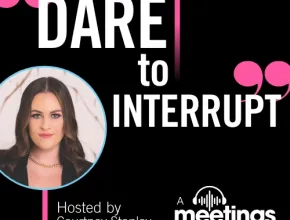How COVID-19 Is Changing Meeting Space Design
Event space design is crucial to the return to live meetings in the wake of the COVID-19 pandemic. In this episode of the Meetings Today podcast, CORT Events’ executive director of marketing and product development, Kevin Dana, discusses key ways the approach to meeting space design is changing in an effort to create events where safety and social distancing are top of mind.
Facilitating movement to ensure a safely spaced event, providing cues to allow for a greater sense of safety, and even reimagining food and beverage areas—plus trends around colors, furniture and technology—are just a few topics covered in this episode.
Listen to this Meetings Today Podcast to find out more.
Enjoying this episode? View more episodes of the Meetings Today Podcast!
Read the transcript below:
[Start transcript]
Danielle LeBreck: Hey, everyone, welcome to the Meetings Today podcast. I'm Danielle LeBreck. Today we will be covering event design and layout trends and how the whole meeting space design approach has changed during the COVID-19 pandemic. This is pretty top of mind right now as we're starting to see some live meetings begin to move forward this fall and into 2021. We have Kevin Dana, executive director of marketing and product development at CORT Events, here with us today to share some of his expert insights on this topic. Thanks for joining us today, Kevin.
 Kevin Dana: You're welcome. Good morning, Danielle. I'm excited to be here with you.
Kevin Dana: You're welcome. Good morning, Danielle. I'm excited to be here with you.
(Photo: Kevin Dana, executive director of marketing and product development at CORT Events)
Danielle: So to start us off, because of COVID-19 and the restrictions on gatherings and social distancing requirements, meetings and events pretty much came to a halt earlier this year. But now as we're moving into late 2020, and into 2021, a lot of these guidelines are still in place. But there are some small gatherings that we're beginning to see move forward. Through our reporting at Meetings Today, we're starting to see trends like micro events, outdoor events and hybrid events come to the forefront. And so, my first question for you is, from an events design perspective, are you seeing some of these same trends? And if you are, how are you rethinking designing event spaces as you plan for these?
Kevin: It's a great question. And yes, we here at CORT Events are already seeing these smaller events pop up around the country, and it really depends on the jurisdiction. Of course, you know, some markets are opening up faster than others, depending on what is allowed. We just saw that Las Vegas is now allowing conventions and meetings up to 1,000 persons, depending on the size of the venue. But, you know, we're going to see venues limited to anywhere from 25% to 50% capacity, and that's what we're seeing so far.
As far as rethinking design, clearly there is many, many fewer people allowed in a particular venue. And then the events we've done so far have been mainly outdoors. But as we move into fall, we know that's not going to be possible in most parts of the country. So, designing events for this new reality in this lower capacity is, you know, of prime importance.
One concept I really love, especially when we're talking about meetings, is the concept of owned space. So, you know, each attendee at a meeting would get their own chair with their own table and charging station, if possible. So, you know, for the duration of any program, event or meeting and conference, that's their own space. And so, I love that concept, because I think that's going to help put people at ease that they know they have a physically distanced place to engage with the program for the duration. And so, you know, they're not having to share that with anybody else.
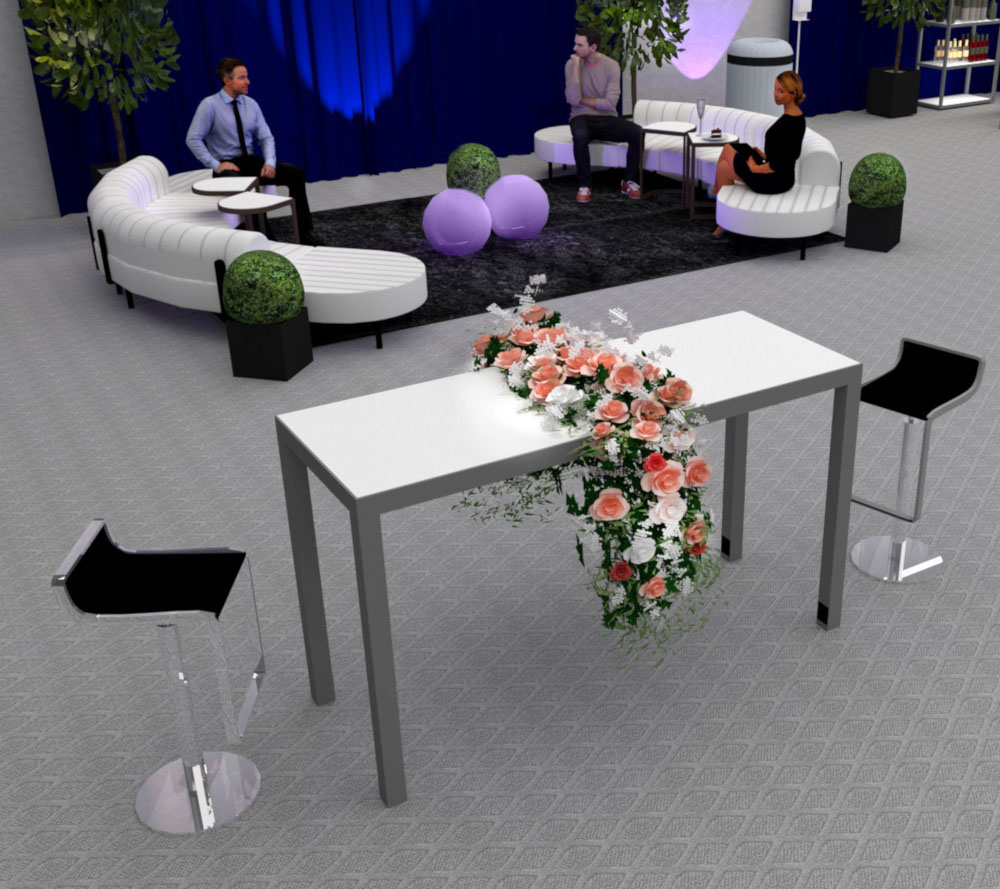
Photo: Physical distancing cues with soft decor touches evokes a sense of safety and comfort. Credit: CORT Events
Danielle: Mm hmm. Like a, like a social bubble, basically.
Kevin: Exactly, you know, physically distanced at least six feet apart. You know, you have to pay attention to space between chairs. Because if you don't have one-way traffic flow, you've got to provide more than six feet. You know, if you're doing two-way traffic flow, you really need 12 feet. So, we've seen meetings that have these individual chairs, accent chairs, typically very comfortable chairs with that corresponding table. But this space between those chairs is much larger. And if you are going to do one-way traffic, decals on the floor and signage are a must. So I think, as we think about designing these meetings, we've got to think about, you know, providing cues to attendees that maybe aren't always in your face, but more subtle, certainly, using dividers, help with wayfinding, the decals. So there's many ways you can do it, to also make it seem like it's a comfortable environment, you don't want signs everywhere, warning people about danger. So, yeah, that's certainly what we're seeing.
[Related: How Biophilic Design in Meeting Spaces Can Boost Productivity]
Danielle: Right. And that kind of leads me into my next question where, you know, like you said, we're seeing venues opening up now, but they're limited by capacity restrictions based on whatever state or city you're in. And also, a lot of these venues have raised their frequency of cleaning—there's a huge emphasis on sanitation of their spaces, and enacting different safety measures to assure attendees that they are entering a safe environment in these buildings. How else are you using event space design to reinforce this sense of safety and comfort for attendees? Like you said, I think that's going to be pretty key to getting live meetings back up and running—it’s making attendees feel both safe and comfortable.
Kevin: Well, I think it begins with the communication beforehand, you know, providing an outline or a guideline for attendees digitally before they arrive, having them pre-registered. So when they arrive, they know what to expect. And one of the most important things and, you know, it does relate to design, because as soon as an attendee has felt comfortable enough to come to a meeting for the first time in months, when they arrive, I think it's really important to have a safety manager or safety greeter there, to kind of put them at ease, give them the lay of the land. And what we're really seeing are wellness checkpoints, so, you know, a counter set up with where they can get their temperature checked and learn about the lay of the land when they get there. And then, that safety manager or greeter then can kind of direct them to where they need to go within the space, to their own space, like I spoke of earlier. And I think, you know, that wellness checkpoints is going to become the norm for a while.
Danielle: Yeah, I think even when we're in the clear after this pandemic, I think the overall emphasis on health and safety and wellness will probably be a lasting thing that we see at events going forward.
Kevin: Yeah. I wanted to add too, you know, some people are going to arrive with someone else in their own social bubble, too. So, we do have to think about areas where eating in particular, you know, we talked about maybe dinner for one where you scattered tables in a cafe, cabaret setup with one chair. But we've heard, well, people, if they arrive with a second person, they're comfortable sitting together with them. So, there has to be a lot of forethought about extra seating, so maybe there's extra chairs. So if somebody is comfortable sitting with somebody else, they can find a chair or have one of the safety managers bring another chair to that table, so they can sit together.
Especially, you know, going to design, those large sectionals, I think are going to be a lot more comfortable for people than like a love seat. And what we've done in event design is we're using large sectionals to create this row of seating but placing individual C-tables that go over seats. So once again, you're providing a visual cue that, oh, you can't sit there but you know, there's no signage, people will just intuitively know you know, that table is there to keep that seat from being used.
Danielle: Right. Kind of a follow up question: Networking is usually a huge piece of events that's usually one of their favorite parts of an event or one of the main reasons they attend an event is to network with their colleagues and in the past for you know, the furniture use has gotten really creative for those sessions. How have you been rethinking the networking spaces too since that is so face-to-face and so social? Is there different furniture you're considering? Is plexiglass a big part of things? Just kind of curious what you’re thinking around that?
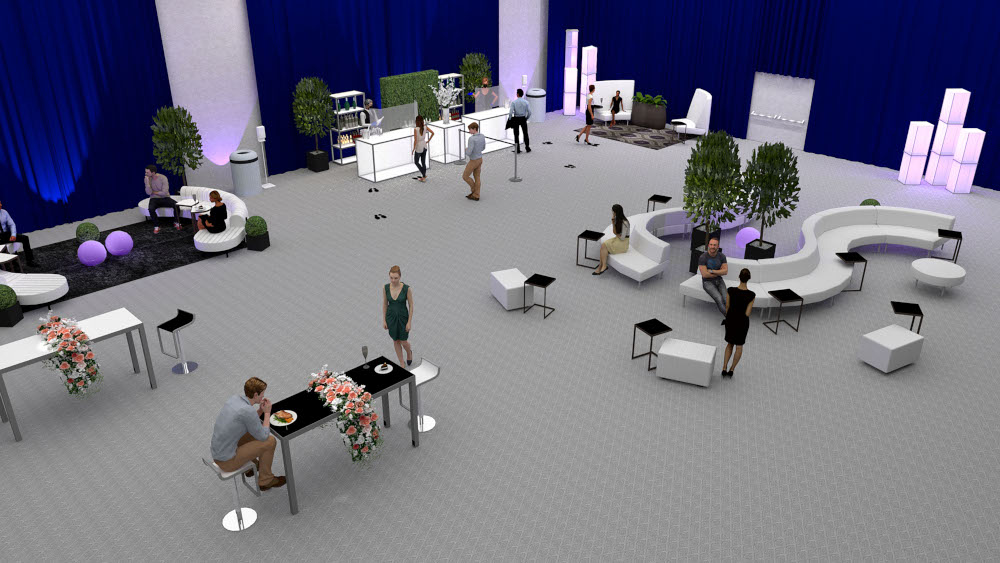
Photo: Event space design is changing because of COVID-19. Credit: CORT Events
Kevin: Yes, we have introduced a complete line of health and safety products, including you know, bar and counter plexi and also freestanding acrylic dividers. And so we are using those in design but once again, you know, you have to be careful about how many you use because you don't want it to look like a sterile antiseptic environment. But I do think that incorporating these in-between some accent chairs or individual seating does help to provide a little bit greater sense of safety for attendees when it comes to designing networking spaces. Again, the footprint has to be much, much larger to be able to create lounge spaces, again, with a seat and individual table for each person. I think communal coffee tables are going to be out for a while. I think side tables that, you know, are individualized for each seat are going to be much more important.
[Related: A Look at Hilton's New Approach to Meeting Space Design]
Danielle: Sure. So transitioning a little bit, I want to talk more about the role that technology is going to play going forward. I think it's safe to say that technology is more important than ever to the meetings and events industry, especially since any meeting that happened probably in the first half of 2020 was 100% virtual. And as venues are prepping for the return of face-to-face meetings, I've seen a lot of them preparing for what we're calling hybrid events, where they're creating broadcast rooms, specifically to stream live meetings to attendees who choose not to attend in person. I'm wondering if you've seen this too, and how you might recommend that these particular spaces be designed to keep virtual attendees’ attention and make it feel like they're part of the event? I would imagine that it needs to be more than just a speaker in front of a computer screen with a blank wall.
Kevin: It absolutely does. We like to call these programs “glocal,” so it's global and local. They’re definitely going to be smaller, local regional gatherings with that broadcasting element to livestream to remote attendees. And in terms of design, there's a couple of ways to go about this.
I love the “talk show” setup, where you might have a moderator sitting behind a desk, and a couple of comfortable chairs in front of it with individual tables, that's physically distanced, incorporating greenery, and, you know, warm lighting, accessories, rugs, just making it feel like a very comfortable environment, set up in that talk show format that really lends itself to more of an entertainment environment. Because you're going to have to entertain and inform and deliver content more like dare I say, a TV show than a classroom. And so then you can livestream that out to attendees in regional meetings that are much, much smaller.
Also, when we speak about technology in the room, for the attendees that are there, I think you're going to see more large monitors around the room on the stage, just so people aren't having to cluster around a monitor. And mobile phones, you know, mobile devices are going to be paramount, because that's really the way to keep your attendees engaged. And whether you're using a live chat feature for real time, comments, questions, polls, all of those things are really going to be used together to create a more engaging environment for those people that are offsite, so they can transmit their questions immediately to that talk show environment.
And I do think if you're using a stage environment, a more traditional stage environment with a lectern—again, the same design should go into that, you know, of course, you're going to have physically distanced chairs on that stage. No communal microphones, of course, but also creating, you know, the design of the stage with greenery and color and lighting that's warm to make attendees feel more comfortable.
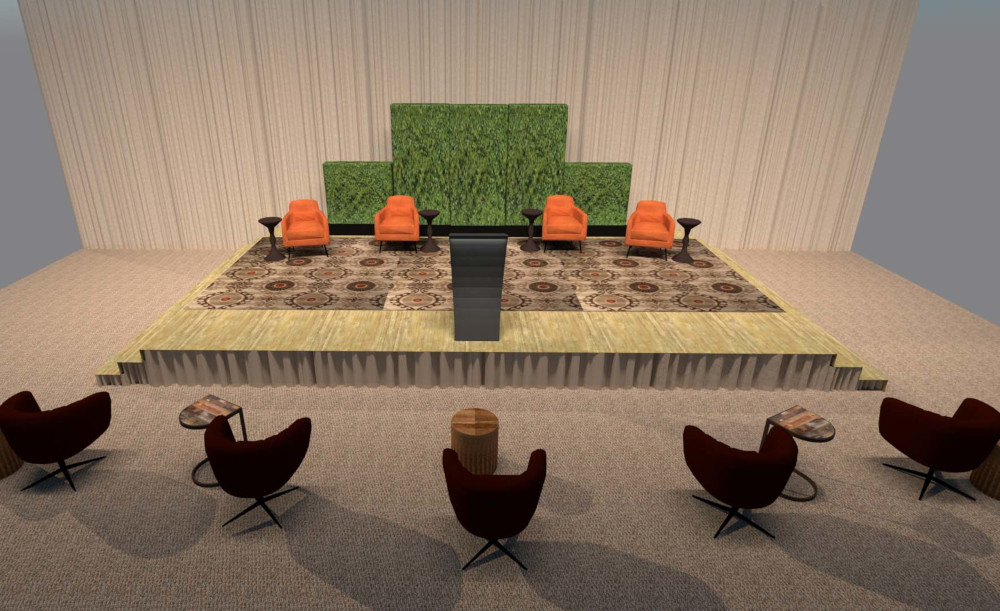
Photo: The talk show stage setup will be key for hybrid meetings. Credit: CORT events
Danielle: Yeah. And I wanted to talk about the decor and colors a little more, because like you said before, it's absolutely rightly so that there's a huge emphasis on cleanliness, sanitation, the spaced out seating designs and the plexiglass barriers. Those are all really important moving forward. But it can create a sort of sterile environment or take the liveliness and fun out of an event. So, can you maybe elaborate a little bit more about small touches that you can use to bring some of the fun and the comfort back into an event? Maybe using colors or decor or different furniture? What would you recommend in that area?
Kevin: Yes, absolutely. So my position in CORT—every year I am attending major furniture shows, both in Europe and the U.S. to stay on top of what the trends are, because the trends in furnishings definitely are important and relate to design for meetings and events. And so the trends that were happening before COVID are still happening.
In terms of color, you know, we've been in kind of a blue environment. The color blue in all shades has been very popular in the last couple of years. But we were seeing already green becoming more prominent, and green in all shades. And that was a major trend that was already happening. And now it just coincides with what's happened with the pandemic. And it just so happens that green is the color of health and wellness. And so I think you're going to continue to see green become more important in decor and design for meetings and events, because it's a calming color, and it does signal, you know, wellness and safety. So green, definitely.
In terms of design, we were seeing an art deco design really come on strong, and Danish modern as well. And that trend just happens to play well in this environment too, because lots of like soft velvet, very comfortable, you know, furnishings, with lots of design details, whether it's design stitching, or prints, and then lots of natural elements, possibly grasses, and I mentioned greenery. So I think that trend, you know, this eclectic environment that really takes a lot of different elements and put them together lends itself to this environment, because attendees again, are going to be very hesitant to come back. And when they get there, you want to make sure that they are comfortable. And the setting that you provide should really feel like home.
[Related: 4 Pre-Event Communication Strategies for Meeting Planners in the Pandemic Era]
Danielle: Yeah. And I guess as you've been monitoring trends, you said that a lot of trends you were seeing pre-pandemic still apply now? Are there any new things on the horizon for maybe 2021 or 2022, that the design community is talking about that you think could apply? Or are we still kind of waiting to see where the next few months take us in terms of being able to gather again?
Kevin: Well, you know, in terms of furnishings, I mentioned side tables were already a big trend, because they are easily moved around, so as people networked and moved around, they could always have a table with them. But now they—like I said—they relate now to this environment, because now it's part of the open space that you can get your small table with your seat. Other trends, you know, Danish modern furnishings, were also trending and lots of curved, soft design elements are trending. And I think that continues to trend, you know, lots of rich fabrics, again, creating a very organic feel in an event by using these soft forms and colors to make attendees feel more comfortable.
So, I think the continuation of the softening of furniture, you know, not so boxy, but more organic. I think that trend is going to continue to get bigger when it comes to design.
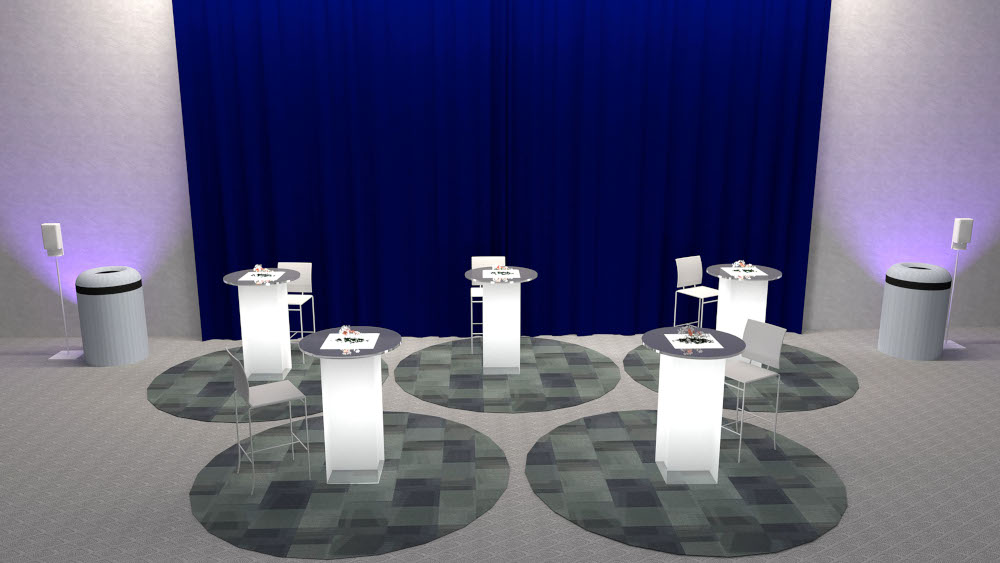
Photo: Owned spaces are an upcoming design trend for events. Credit: CORT Events
Danielle: And finally, my last question for today, and you touched on this a little bit earlier, but I’d just like to get your thoughts. When this pandemic is over, hopefully sooner rather than later, do you think a lot of these design and layout shifts that have happened because of the pandemic will remain? You know, this emphasis on social distancing and more attention to overall health? Do you think this will be a really big factor when planning events moving forward, whether they're small or large? I guess to sum it all up, has this fundamentally changed how we design event spaces?
Kevin: I do think so, especially in the short term. I like to use the term “physical distance for social connection.” So rather than social distancing, because, you know, the reason why you attend a meeting or an event is to have that connection and to network and so that desire is still there. But people are really going to be reticent for the next couple of years, I think, to come back, and so I don't think we're going to be designing the way we were pre-pandemic.
We're going to be thinking about more space for people to move around in. So they can keep the physical distance, and then design so they can still network, but you know, maybe a little bit further apart. I was talking to somebody about music and entertainment, and you're going to have to really think about that. Music is going to have to be lower, because I do think people are going to continue to keep their distance for a little while. And, and I do think that masks, you're going to see those at meetings and events, at least for the next year, where, you know, they're going to be required for most programs and tradeshows, as well. So, to emphasize, the things that we're doing now in design are going to continue, and I'm going back to my original first point about owned space, especially when it comes to a meeting. Assigning those spaces in advance, communicating how an event or a meeting is going to be run, and then making sure that the attendees when they get there know what to expect.
Danielle: Yeah. Well, this has been really helpful. You've given us a lot to think about and a lot of actionable advice for meeting professionals who are actively planning live events right now. So, thank you so much for sharing your perspective on these topics today, Kevin. I really appreciate it.
Kevin: You’re welcome, Danielle. This has been fun.
Danielle: And for those of you listening, you can see some layout design examples that Kevin referenced and that we discussed on meetingstoday.com/podcasts, if you're interested in learning more, or reach out to CORT Events. You can also find a whole library of additional podcasts on important topics in the meetings industry on our website or on your favorite podcast platform. And we also have plenty of free webinars, helpful articles and more to help you guys navigate these tough times. So that wraps things up for today. Thank you all for tuning in and have a great week.
[End transcript]
Listen to more Meetings Today podcasts
- How a Disney World Hotel Handled the MLS COVID-19 Bubble
- CVENT Execs Talk Trends and CONNECT Virtual
- F&B With Tracy Stuckrath: From COVID to Food Allergies and Beyond




